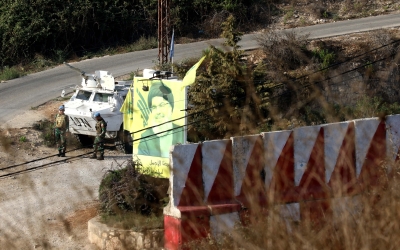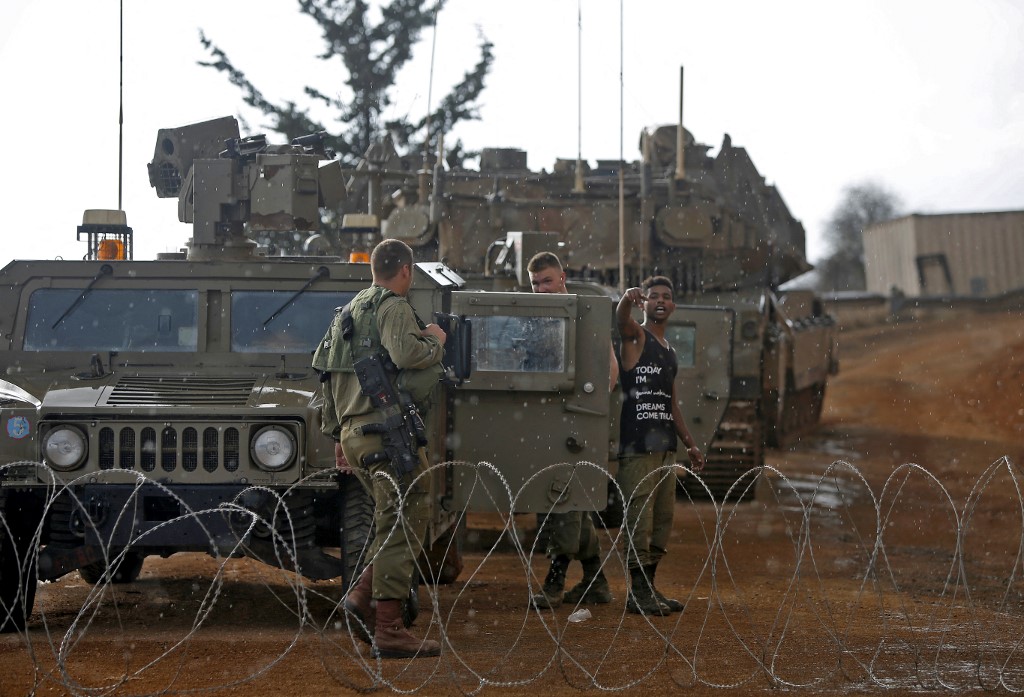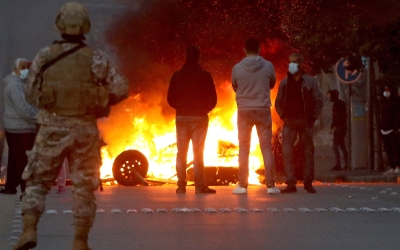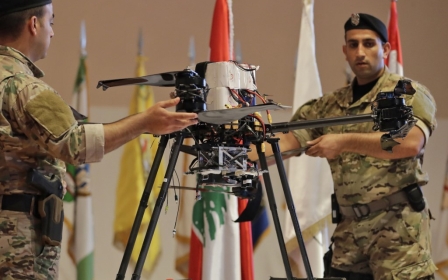Syria: How to prevent Israel-Iran shadow war spinning out of control
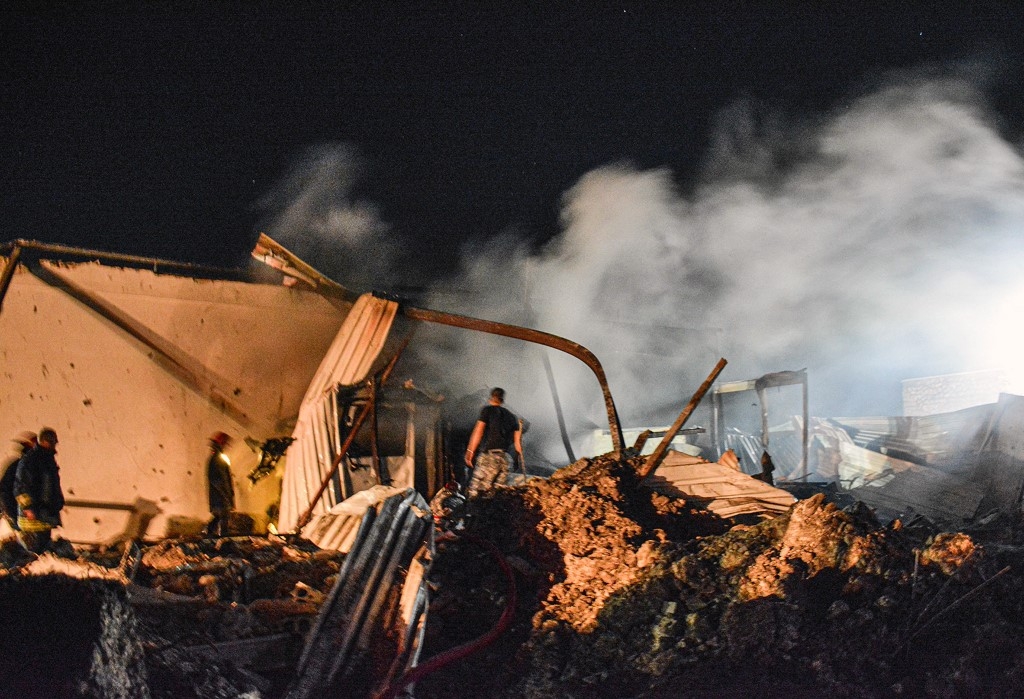
The explosion of a Syrian anti-aircraft missile in southern Israel on 22 April, followed by Israeli attacks around the northern city of Latakia on 5 May, were only the latest episodes of the shadow war that Israel and Iran have been fighting in war-ravaged Syria for several years. They will not be the last.
Neither side wants these occasional flareups to grow into a fully fledged confrontation. But the risk of escalation is real due to potential miscalculations or technical errors in both sides’ attempts to achieve tactical gains.
The involvement of Hezbollah, Tehran’s most important non-state ally, in the Syrian theatre carries a further risk that comparatively low-level altercations in Syria may spill over into Lebanon and trigger a destructive conflict between the heavily armed Shia group and Israel.
A more likely escalation scenario would be the killing of Hezbollah operatives embedded with Iran-backed militias in Syria, an event that could spill over into Lebanon
The current diplomatic re-engagement between the US and Iran is welcome, but it is unlikely to put an end to this shadow war, even if it leads to the successful revival of the 2015 nuclear deal. Both Tel Aviv and Tehran seek to secure their strategic positions in the post-Trump era, while a settlement for the Syrian conflict remains elusive.
Israel has conducted an initially covert, but increasingly open, campaign against what it sees as deepening Iranian entrenchment in Syria over the past decade. In what has become known in Israeli circles as the “campaign between wars”, the Israeli army has bombed Iranian-linked militias, weapons shipments to Hezbollah and Iranian military installations - in particular to the southwest of Damascus, but sometimes as far east as al-Bukamal on the Iraqi border and Masyaf in the north.
More recently, the Israeli army reportedly also targeted Iranian fuel shipments to Syria on the high seas, claiming that Iran uses these to smuggle weapons.
Sporadic retaliation
Iran and its allies, including the Syrian regime, have for the most part absorbed these strikes. They have only sporadically attempted to retaliate, namely when the attacks have caused major casualties. In May 2018, some 20 missiles launched from Syrian territory, which the Israeli army said were fired by the Iranian Quds Force, targeted Israeli military positions in the Golan Heights. The volley was likely a response to an Israeli attack on the Tiyas airbase near Homs a month earlier that killed at least seven Iranians.
The likelihood of Iranian casualties significantly decreased when Russia, which controls Syria’s airspace west of the Euphrates, obliged Israel to give prior notice of operations there, after one such operation led to the accidental downing of a Russian military aircraft by Syrian air defence, killing 15 Russian servicemen. It is generally assumed that the Russian military is passing on such information, giving the Iranians enough time to move their personnel out of harm’s way.
A more likely escalation scenario would be the killing of Hezbollah operatives embedded with Iran-backed militias in Syria, an event that could spill over into Lebanon. In August 2019, Hezbollah Secretary General Hassan Nasrallah explicitly vowed that such casualties would draw retaliation from Lebanon against Israel, raising the spectre of an all-out confrontation between the two sides.
The threat, which effectively aimed to expand the existing deterrence between Israel and Hezbollah to the Syrian theatre, came in the aftermath of an Israeli attack in Syria that killed two Hezbollah members, followed almost immediately by a drone attack in the southern suburbs of Beirut that allegedly targeted a key component of Hezbollah’s missile infrastructure. The response came exactly a week later, on 1 September 2019, when Hezbollah struck at and narrowly missed a military vehicle inside Israel.
Precarious balance of deterrence
This last chain of events in particular illustrates the danger that low-level altercations in Syria may upset the precarious balance of deterrence that has prevailed between Hezbollah and Israel since their 2006 war. Simply put, both players are aware that a new direct confrontation would incur intolerable damage to their own side, and are hence keen to avoid it.
At the same time, both also believe that credible deterrence is the safest way to avoid such a scenario, and that this requires signalling to the enemy their readiness to risk a confrontation if certain red lines are crossed. According to Israeli media, the Israeli army had stood ready to retaliate to Hezbollah’s 1 September response with a devastating blow. This would likely have prompted Hezbollah to respond yet again in kind. Israel called off the retaliatory strike once it became clear that none of its soldiers had been harmed.
Since then, calm has mostly prevailed on the Lebanese-Israeli border, but this should not be taken for granted. On the surface, Hezbollah showed reluctance to deliver on Nasrallah’s commitment the last time one of its operatives, Ali Kamel Mohsin, was killed near Damascus last July.
Immediately after that incident, the group claimed that Israel sent a message through the UN containing what amounted to an “apology” for the “unintentional” killing of Mohsin, which supporters cited as proof that Israel was “in a state of continued confusion and fear”.
The following month, Hezbollah vehemently denied Israeli claims of a botched border incursion, and quoted the heightened state of alert on Israel’s northern border as material proof that Hezbollah’s deterrence remained effective.
Ultimately, however, such rhetorical manoeuvring will not be enough. From the perspective of Hezbollah, standing down for too long would be read as a sign of weakness and encourage Israel to step up the pressure. By this logic, maintaining the balance of deterrence that has kept the border mostly quiet for the past 15 years would require real military action should Israel continue to carry out attacks against the group, whether in Lebanon or Syria.
Bracing for trouble
The Israeli military, for its part, is bracing for rough months ahead. According to its annual intelligence assessment published this past February, Hezbollah is moving towards a more aggressive posture, and is increasingly ready to risk limited confrontations along the border.
On 27 January, Israeli Army Chief of Staff Aviv Kochavi devoted some 10 minutes [27:30 to 38:30] of a 50-minute public presentation to explaining that in the event of such a conflict, it would be legitimate and necessary for the Israeli army to attack suspected weapons-storage and launching facilities embedded within densely populated residential areas in Lebanon - though he added that Israel would do so only after giving enough warning for civilians to evacuate.
From the Iranian perspective, reinstating restrictions on its nuclear programme may appear as a significant concession that makes it necessary to reinforce other points of strength
Israel’s most influential think tank, the same one that hosted Kochavi’s speech, has argued for a more forward-leaning posture in Syria, and Israeli sources have fed alarming information to international media about an alleged build-up of Iranian capacity to store and produce advanced weapons in Syria, suggesting that Israel is preparing to step up its campaign there.
While these reports partly reflect what is known about the current Iranian strategy for the proliferation of weapons to its allies, namely an increasing reliance on technology transfer that enables local manufacturing, it is not clear to what extent this represents a substantial increase or a qualitative shift in the threats that Israel has faced in recent years. For one, these reports stand in some contrast to previously reported assessments that Israeli attacks have gone a long way towards undermining Iran’s entrenchment in Syria.
Hezbollah, for its part, insists it aims for deterrence, and so far there are no indications to the contrary. Rather than a significant shift in the strategic balance, the most plausible reason for Israel’s increasingly bellicose posture appears to be the shift in the new US administration’s Iran policy - namely, the move away from the Trump-era “maximum pressure” on Iran to renewed diplomatic re-engagement and a return to the nuclear deal.
Doomsday scenarios
Israel has made no secret of its misgivings about Washington’s new policy line, going as far as warning that it may send the region “spiralling into war”. Whether the current political and military leadership in Tel Aviv actually believes it will need to bring about such doomsday scenarios is unclear.
One objective behind emphasising the Iranian threat is certainly to urge the US to condition a return to the nuclear deal on addressing what Israel sees as Tehran’s problematic behaviour across the region - namely, its ballistic-missile programme, support for non-state actors, and, in the Israeli government’s eyes, undermining of regional security.
While the Biden administration has sought to reassure its Israeli ally that it will eventually follow up on these issues, they are not on the agenda in the current Vienna talks. Nor is Tehran likely to reduce its footprint across the region and draw down its presence in theatres such as Syria of its own accord, once a deal is secured.
From the Iranian perspective, reinstating restrictions on its nuclear programme may appear as a significant concession that makes it necessary to reinforce other points of strength in its strategic posture. During the Trump era, Iran’s strategy of asymmetric deterrence and defence through a conglomerate of state- and non-state actors proved effective against an impressive array of external adversaries endowed with far more resources and diplomatic clout.
The Iranian leadership may well opt to double down on this approach, not least to hedge against a possible return of the US to a more confrontational approach after the next US presidential election in 2024.
Mediating role
Israel may want to curtail the increasing margin of manoeuvre that the end of “maximum pressure” may award Iran by increasing pressure of its own in places such as Syria. If Iran were to respond violently, this could also serve to vindicate warnings against its nefarious intentions and convince Israel’s allies, in particular the US, to partner with Tel Aviv in containing Tehran.
Yet, with Russia ultimately calling the shots in Syria, and with Israel’s newfound Arab partners moving towards a more accommodating stance as well, there are clear limits to such an approach.
The likeliest scenario is that the jostling between Israel and Iran, and by extension Hezbollah, for position in the Syrian theatre will continue for the foreseeable future. In the meantime, the challenge will be to prevent occasional spikes of violence from spinning out of control.
Russia, which maintains good contacts with all sides, appears best positioned for a mediating role, which it already performed in the run-up to the regime’s offensive to take back rebel-held areas along Syria’s border with Israel in June 2018.
Preventing conflict in the triangle between Tel Aviv, Beirut and Tehran would be a smart move for Moscow to protect its political and military investment in Syria.
The views expressed in this article belong to the author and do not necessarily reflect the editorial policy of Middle East Eye.
Middle East Eye propose une couverture et une analyse indépendantes et incomparables du Moyen-Orient, de l’Afrique du Nord et d’autres régions du monde. Pour en savoir plus sur la reprise de ce contenu et les frais qui s’appliquent, veuillez remplir ce formulaire [en anglais]. Pour en savoir plus sur MEE, cliquez ici [en anglais].



